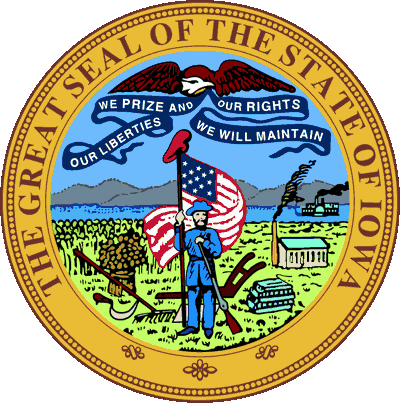- » 50 States
- » Histories
- » State Symbols
- » Seals
Iowa State Seal
Great Seal of the State of Iowa

Adopted in 1847.
One of the initial acts of the first Iowa Legislature in 1847 was to create the Great Seal of Iowa.
The two-inch diameter seal pictures a citizen soldier standing in a wheat field, holding an American flag, surrounded by farming and industrial tools. A cultivator rests in the field behind him, smoke trails from the chimney of a small cabin, and a ship steams through the water of the Mississippi River in the background. An eagle is overhead, holding in its beak a scroll bearing the state motto, "Our liberties we prize, and our rights we will maintain." The motto was the work of a three-man Senate committee and was incorporated into the design of the seal at their suggestion..
Iowa Great Seal
It was approved by the First Iowa General Assembly on February 25, 1847. Since that date, there have been no revisions to the code governing this Seal. The Seal of Iowa is kept and used by the Governor for official purposes. Because the seal was not illustrated in the Iowa code, over the years there have been several variations with differences in color and arrangement of objects.
The seal was not universally beloved when introduced, it was considered cluttered and ungainly, and the older Territorial Seal was utilized in several instances on official publications into the 1860s, including official currency. "Gov. Lowe, who, with every other gentleman of refinement, cannot but regret the bad taste that conceived and adopted the conglomerate devices of our present 'Great Seal'.
The Great Seal cannot be used without the permission of the Governor. The state seal is retained in the custody of and under the control of the Governor, who uses the seal for official documents and functions.
Symbols on Iowa Seal
- Citizen soldier: The seal was approved during the Mexican-American War of 1846-1848, and the citizen soldier depicted with a "liberty cap" represents volunteer soldiers from Iowa. Battles of the Mexican-American war are also memorialized in several place names, including the counties of Buena Vista, Palo Alto and Cerro Gordo. As is traditional in official symbols, weapons are held in the soldier's left hand, and items of peace and freedom in the right.
- Liberty Cap: A "liberty cap", also called a Phrygian cap, is a brimless hat resembling a tall beret that is an ancient Greek symbol of freedom. However, the soldier on the seal typically wears a wide-brimmed hat that resembles a Civil War-era Cavalry hat. Most versions of the seal put the liberty cap on top of the flag staff, presumably because the artists felt the cap did not match the soldier's uniform, which typically resembles that of a Civil War Union soldier.
- Wheat: Early settlers in the 1840s primarily planted wheat, it was not until the introduction of the railroad in the 1850s and 1860s that corn became the primary crop of Iowa.
- Lead: Lead mining in the Dubuque region was an early economic force; no lead is mined in Iowa today. A "pig" is a large slab of lead shaped in a furnace mold with four corners that protrude slightly to facilitate handling; thought to resemble the animal pig.
- Steamer Iowa; The Steamboat Iowa was revered as one of the largest and fastest boats on the Mississippi; it set the speed record from Galena, Illinois to St. Louis in 1843, making the trip in 44 hours, a record that held until 1849. The Mississippi was the primary route of transportation in Iowa in the 1840s, and most large Iowa towns were on or near the Mississippi.
- Eagle; The federal Eagle was used in the earlier Seal of the Iowa Territory, and this symbol holding a banner with the motto of Iowa on it was incorporated into the Flag of Iowa.
Iowa Law
TITLE I STATE SOVEREIGNTY AND MANAGEMENT
SUBTITLE 1 SOVEREIGNTY
CHAPTER 1A GREAT SEAL OF IOWA
1A.1 Seal - device - motto.
1A.1 Seal - device - motto.
The secretary of state be, and is, hereby authorized to procure a seal which shall be the great seal of the state of Iowa, two inches in diameter,
upon which shall be engraved the following device, surrounded by the words, "The Great Seal of the State of Iowa"- a sheaf and field of standing
wheat, with a sickle and other farming utensils, on the left side near the bottom; a lead furnace and pile of pig lead on the right side; the citizen
soldier, with a plow in his rear, supporting the American flag and liberty cap with his right hand, and his gun with his left, in the center and near
the bottom; the Mississippi river in the rear of the whole, with the steamer Iowa under way; an eagle near the upper edge, holding in his beak a scroll,
with the following inscription upon it: Our liberties we prize, and our rights we will maintain.
Section History: Early form
[1GA, ch 112; C75, 77, 79, 81, §1A.1]
Referred to in §2A.1
Footnotes
Editor's Note: The Act of the First General Assembly of the State of Iowa creating the Great Seal, approved February 25, 1847, is hereby reproduced
in the descriptive part.
There seem to be no further enactments, repeals, or amendments and no codification of this law appears in the various Codes. See Annals of Iowa, Volume
XI, pages 561, 576. Constitutional provision for a great seal is contained in Iowa Constitution, Art. IV, §20, but no description is provided.








